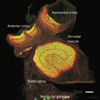Ion channels in mammalian vestibular afferents may set regularity of firing
- PMID: 18490392
- PMCID: PMC3311106
- DOI: 10.1242/jeb.017350
Ion channels in mammalian vestibular afferents may set regularity of firing
Abstract
Rodent vestibular afferent neurons offer several advantages as a model system for investigating the significance and origins of regularity in neuronal firing interval. Their regularity has a bimodal distribution that defines regular and irregular afferent classes. Factors likely to be involved in setting firing regularity include the morphology and physiology of the afferents' contacts with hair cells, which may influence the averaging of synaptic noise and the afferents' intrinsic electrical properties. In vitro patch clamp studies on the cell bodies of primary vestibular afferents reveal a rich diversity of ion channels, with indications of at least two neuronal populations. Here we suggest that firing patterns of isolated vestibular ganglion somata reflect intrinsic ion channel properties, which in vivo combine with hair cell synaptic drive to produce regular and irregular firing.
Figures



Similar articles
-
Ion channels set spike timing regularity of mammalian vestibular afferent neurons.J Neurophysiol. 2010 Oct;104(4):2034-51. doi: 10.1152/jn.00396.2010. Epub 2010 Jul 21. J Neurophysiol. 2010. PMID: 20660422 Free PMC article.
-
Enhanced Activation of HCN Channels Reduces Excitability and Spike-Timing Regularity in Maturing Vestibular Afferent Neurons.J Neurosci. 2019 Apr 10;39(15):2860-2876. doi: 10.1523/JNEUROSCI.1811-18.2019. Epub 2019 Jan 29. J Neurosci. 2019. PMID: 30696730 Free PMC article.
-
Low-voltage-activated potassium channels underlie the regulation of intrinsic firing properties of rat vestibular ganglion cells.J Neurophysiol. 2008 Oct;100(4):2192-204. doi: 10.1152/jn.01240.2007. Epub 2008 Jul 16. J Neurophysiol. 2008. PMID: 18632889
-
Afferent diversity and the organization of central vestibular pathways.Exp Brain Res. 2000 Feb;130(3):277-97. doi: 10.1007/s002210050033. Exp Brain Res. 2000. PMID: 10706428 Free PMC article. Review.
-
Hair cells in mammalian utricles.Otolaryngol Head Neck Surg. 1998 Sep;119(3):172-81. doi: 10.1016/S0194-5998(98)70052-X. Otolaryngol Head Neck Surg. 1998. PMID: 9743073 Review.
Cited by
-
Models of vestibular semicircular canal afferent neuron firing activity.J Neurophysiol. 2019 Dec 1;122(6):2548-2567. doi: 10.1152/jn.00087.2019. Epub 2019 Nov 6. J Neurophysiol. 2019. PMID: 31693427 Free PMC article. Review.
-
Distribution of high-conductance calcium-activated potassium channels in rat vestibular epithelia.J Comp Neurol. 2009 Nov 10;517(2):134-45. doi: 10.1002/cne.22148. J Comp Neurol. 2009. PMID: 19731297 Free PMC article.
-
Spontaneous dynamics and response properties of a Hodgkin-Huxley-type neuron model driven by harmonic synaptic noise.Eur Phys J Spec Top. 2010 Sep;187(1):179-187. doi: 10.1140/epjst/e2010-01282-3. Eur Phys J Spec Top. 2010. PMID: 20975925 Free PMC article.
-
Molecular logic for cellular specializations that initiate the auditory parallel processing pathways.bioRxiv [Preprint]. 2024 Oct 6:2023.05.15.539065. doi: 10.1101/2023.05.15.539065. bioRxiv. 2024. Update in: Nat Commun. 2025 Jan 9;16(1):489. doi: 10.1038/s41467-024-55257-z. PMID: 37293040 Free PMC article. Updated. Preprint.
-
Ionic direct current modulation evokes spike-rate adaptation in the vestibular periphery.Sci Rep. 2019 Dec 12;9(1):18924. doi: 10.1038/s41598-019-55045-6. Sci Rep. 2019. PMID: 31831760 Free PMC article.
References
-
- Av-Ron E, Vidal PP. Intrinsic membrane properties and dynamics of medial vestibular neurons: a simulation. Biol. Cybern. 1999;80:383–392. - PubMed
-
- Baird RA, Desmadryl G, Fernández C, Goldberg JM. The vestibular nerve of the chinchilla. II. Relation between afferent response properties and peripheral innervations patterns in the semicircular canals. J. Neurophysiol. 1988;60:182–203. - PubMed
-
- Bäurle J, Vogten H, Grüsser-Cornehls U. Course and targets of the calbindin D-28k subpopulation of primary vestibular afferents. J. Comp. Neurol. 1998;402:111–128. - PubMed
-
- Bean BP. The action potential in mammalian central neurons. Nat. Rev. Neurosci. 2007;8:451–465. - PubMed
Publication types
MeSH terms
Substances
Grants and funding
LinkOut - more resources
Full Text Sources
Other Literature Sources

